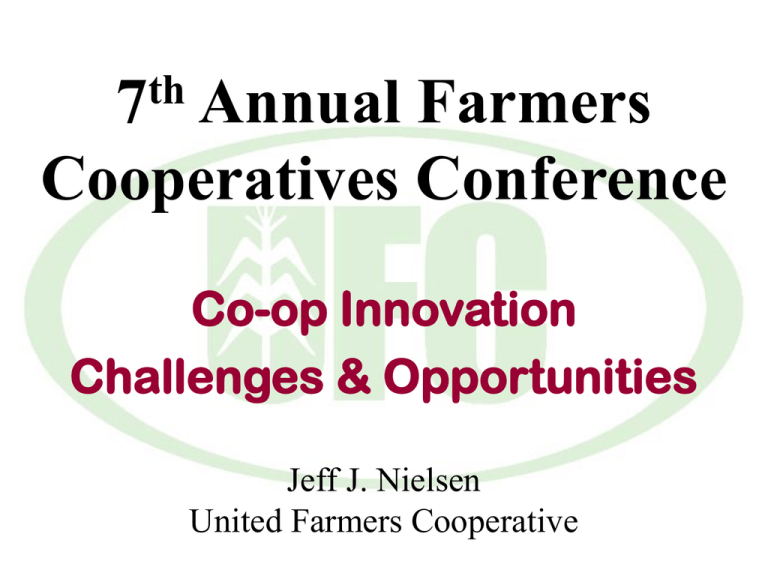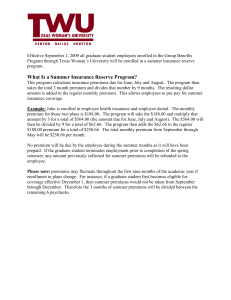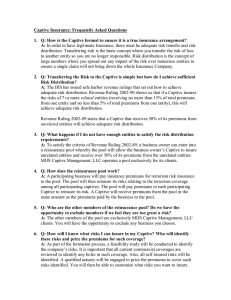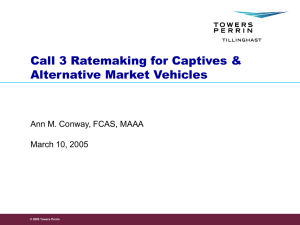7 Annual Farmers Cooperatives Conference Co-op Innovation
advertisement

th 7 Annual Farmers Cooperatives Conference Co-op Innovation Challenges & Opportunities Jeff J. Nielsen United Farmers Cooperative UFC – Quick Overview • Parent Co-op Established in 1915 • 2004 Revenues just over 80 million dollars • 10,000 Members – approx 2,500 Active Producers • Diversified Business Base – Grain, Feed, Agronomy, Petroleum, Farm Equipment and Construction, and Consumer Goods • Approximately 100 Full Time Employees • Trade Area Includes – 8 Communities and 15 Service Locations Performing on the Promise UFC’s Promise To supply our customers with technology, products, and services in a manner that is extraordinary enough to add value to their lives. Cooperative Innovations UFC’s Decision Parameters • • • • • • • Must Focus on Long Term Benefit Must Fit our Promise “Calculated Risk”- OK, how much? Must Never Forget Your Core Values Can We Be the Best – or Build To It Know When to Get Out/Say No Focus on “Customer Driven Solutions” Co-op Innovation – UFC Projects • 1995 Developed Livestock Systems to Serve All Members – Built Local Demand for Corn • 1999 Developed Employee Owned and Controlled Health Insurance Program • 2000 Help to Pioneer Broadband Services for Rural America – Formed RTS Services • 2001 Developed Innovative Marketing Programs for Core Business – “A.C.R.E.S.” • 2003 Led the Effort to Create a Member Owned Alternative Insurance Program – “Parthenon Risk Partners” Cooperative Innovations Project development path “Parthenon Risk Partners” A cooperative insurance alternative Insurance - Defined Insure 1. The \In*sur"ance\, n. [From Insure.] act of insuring, or assuring, against loss or damage by a contingent event; a contract whereby, for a stipulated consideration, called premium, one party undertakes to indemnify or guarantee another against loss by certain specified risks. Assurance Addressing Risk Alternatives “Traditional Insurance Models” • Remember – Insurance is Simply a “Risk Transfer” Mechanism • Everyone is in the Pool • Highest Risk Drives It • We ALL pay ………….. We ALL share the BURDEN regardless of our personal involvement With Traditional Insurance The Bottom line is….. More Risk + More Exposure Combined with little or no control = Bigger & BIGGER PREMIUMS • No one really has a crystal ball • Very little control / influence • Victims of outside circumstances Insurance Revenue Streams What Effects Changes? 1. Major Loss Events (i.e. 911) 2. Investment Income (stock market performance) 3. Individual or Group Historical Performance 4. Supply and Demand Economics (lack of fair competition) Agri-Business Insurance • Premiums have increased over 100% in the past 4 policy renewals • Agri-business cooperative premiums today are over 780 million • 700 million in premiums from 775 Cooperatives • Four years ago there were 8 major carriers and today it has decreased to 4 with NFU exit OUCH! Policy 2004 P & C Commercial Guard 2003 2002 2001 2000 5 Year Total 376,287 283,233 129,207 85,860 83,936 958,523 42,473 60,149 19,789 11,260 9,151 142,822 Directors & Officers Liab. 5,300 5,210 6,708 4,292 4,100 25,610 Pollution Liability 8,137 6,695 5,923 5,150 0 25,905 355,287 161,627 106,562 Umbrella P&C Total 432,197 Worker's Compensation 119,641 117,100 96,761 73,182 58,324 465,008 Employee Group Health 390,502 364,692 350,553 313,129 218,935 1,637,811 Employee Ins Total 510,143 Total Company Insurance $ 942,340 481,792 $ 837,079 447,314 $ 608,941 97,187 386,311 $ 492,873 1,152,860 277,259 $ 374,446 2,102,819 $ 3,255,679 Hard Facts / Hard Market The cost of insuring our people, property, and assets has become almost unbearable. “You cannot escape the responsibility of tomorrow by evading it today” Abraham Lincoln Commitment / Solutions ? Performing on the Promise Cooperation - Defined “The combination of persons for purposes of production, purchase or distribution for their joint benefit.” Alternative Risk Solutions The Alternative Risk Marketplace currently holds a 55% market share of all commercial insurance premium dollars world wide. The Alternative Risk Industry is comprised of many risk transfer vehicles. These may include: • • • • • Risk Retention Groups Retention Programs Risk Purchasing Groups Self Funded Plans On Shore or Off Shore Captive Insurance Companies The most popular Alternative Risk Transfer Vehicle worldwide is the Captive Insurance Company Formation. What is a Captive Insurance Company? A well –accepted definition of a “captive” is as follows: “A closely-held insurance company whose insurance business is primarily supplied by and controlled by its owners, and in which the original insureds are the principal beneficiaries.” What is a Captive Insurance Company? • Captive insurance companies are entities that have been created to: Insure the property and casualty exposures of their founding organizations Reduce operational costs Take advantage of underwriting profit and investment profits Take advantage of certain tax opportunities Historical Perspective • First Captive – Late 1800’s – Textile Industry (fires) – Became “Factory Mutual System” • Nearly 100 captives by 1950 • By 2002 over 4,500 companies with premiums well over 40 billion • 50% of commercial market is now “Self Insured” Self Insurance Principles General Overview • Members of common risk/exposure collaborate to share risk • Group then shares first two levels of risk – Individual Deductible – Group Deductible – “POOL” • Group purchases Re-Insurance to Cover Major Exposures (protects pool per incident) • Group is responsible for risk management – share the reward if risk is managed well • Additional benefits can be realized as the group/company builds strength Introducing “Pillar Insurance Ltd.” • Officially formed March 2004 • Domiciled in Cayman Islands • Currently 23 Members MN only today $6.0 Million in P & C Premium $1.5 Million in Workers Compensation Premium $1.0 Million in Umbrella Premium • Operational July 1st, 2004 Who Formed Pillar Insurance? • In January 1993, a group of cooperatives took control of their workers compensation needs and started a self insurance company (Access Insurance Association) • Today, in its 12th year of operation, Access has grown from 8 Members to 36 Members • At their annual meeting in 2003, the Members of Access decided to look at the feasibility of self insurance for their property and casualty needs • After a year of the initial feasibility and start up, Pillar Insurance was incorporated in March of 2004 and started operations July 1st, 2004 with 23 founding member co-ops What is Pillar Insurance Ltd.? • • • A captive reinsurance company to the fronting company or CWIC Domiciled in the Cayman Islands (lower capital requirements, taxation, expertise) Similar to a cooperative Members of common business band together to share risk in return for increased efficiencies, underwriting profits and investment profits Controlled by the Membership who elects a Board of Directors from the Membership Board of Directors hires management and other vendors for operations Members share two levels of risk • Member individual deductible or retention • Group deductible or retention – “Pool” One Member – One Vote Profits and Losses are allocated and distributed based on amount business (premiums) and loss history of each Member Tax treatment of profits – Option of Qualified or Non-Qualified Marketed in the United States by Parthenon Risk Partners Introducing Jeff Nielsen, Board Chairman Dennis Pap, General Manager Courtney Claflin, RJF Agencies Coop Innovation – Crucial Components To Achieve “Customer Driven Solutions” • Pro-Active Engaged Membership – – – – Consistent Communication Say This Do This Be Flexible – Open to Change Everything won’t please everyone • Pro-Active/Visionary Board – Innovative Mindset – Think long term – act short term • Don’t Be Afraid to Fail – Take Calculated Risk • Begin with the End in Mind – See It Through “Never doubt that a small group of committed citizens can change the world In fact, it is the only thing that ever has” Margaret Meade






